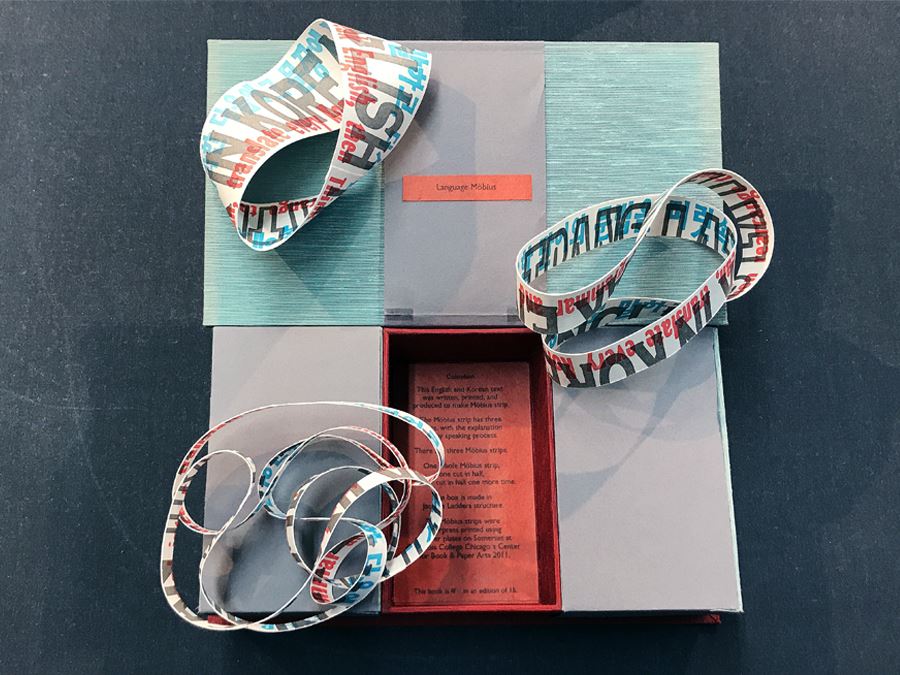Audre Lorde’s 1977 essay Poetry Is Not A Luxury is compact in its 1,242 words, urgent in the delivery of its main message: that the “revelation or distillation of experience” – the poetry that women carry within themselves – is “not only dream or vision, it is the skeleton architecture of our lives.”
The exhibition POETRY IS NOT A LUXURY currently installed at the San Francisco Center for the Book showcases work of female artists who weave these aforementioned revelations and distillations through the core of their art practice. “There are no new ideas,” Lorde writes in her essay, “There are only new ways of making them felt…while tasting our new possibilities and strengths.” Curator Maymanah Farhat explains in her introductory catalog essay that artist books, correspondence art, and zines provide a landscape for female artists to explore ideas of feminism, personal autonomy, and artistic vision, often with an eye to easily sharing these narratives with others. For this exhibition, themes of community, collaboration, and communication are essential to Farhat’s curatorial choices, as well as Lorde’s message that “poetry,” for women, is an urgent necessity of one’s own personhood.
Exhibited in SFCB’s gallery, the artist book Ana Mendieta (2004) by Cuban publishing collective Ediciones Vigía in collaboration with Nancy Morejón is striking in appearance: tall, slender, with a silhouette of a woman criss-crossed in ropes on the cover. Flaming items surround her body: a cross, a dove, a lamp. Upon opening the book, a reader is confronted with a wealth of materials which reference Mendieta’s earthworks: sand, egg shells, earth colored paper. A true collaboration between poet (Nancy Morejón) and publisher (Ediciones Vigia), the reader also becomes a willing third collaborator, experiencing Ana Mendieta with each page turn.

Ana Mendieta :: Ediciones Vigía, Nancy Morejón
Oakland, CA artist Patricia Tavenner was best known for her work in the worlds of correspondence art and zines. Tavenner actively corresponded with other feminist artists such as Eleanor Antin, Lucy Lippard, and Kathy Acker; her publication “Mail Order Art” was one of the first collaborative magazines of the correspondence art genre to feature essays, artworks, and interviews.
As part of the current exhibition, Tavenner’s self-published Four Years and More (1979) is a collection of personal musings and artworks. Reading through Four Years and More, one quickly realizes that community building and fierce independence were important paths for Tavenner. Proclaiming “I AM NOT A CONVENTIONAL ARTIST AND I NEVER HAVE BEEN,” she writes about the early collaborative beginnings of “Mail Order Art”: “I had no idea whether other artists were into the concept of art-by-mail…what I wanted most from this art shopper/newspaper was dialogue. As it turned out, so did others.” Patricia Tavenner’s life exemplified Lorde’s idea that one’s personal poetry is the “skeleton architecture of our lives,” the inner scaffolding upon which we hang everything else we create, live, and do.

Four Years and More :: Patricia Tavenner
Jana Sim’s Language Möbius (2011) is an elegant 3D representation of communication and learning a language outside of one’s native tongue. Sim states:"The most difficult part of learning another language is everyday conversation where an immediate response is needed. Language Möbius is about my conversation process.”
Three Möbius strips housed in a Jacob’s Ladder clamshell box represent the parsing out of language, the different phases Sim goes through (she calls it “the loop in my brain”): hearing English, thinking in Korean, then translating and speaking a reply in English. Two smaller Möbius strips (which are halved versions of the complete third) symbolize, in Sim’s words “the two languages tangled up in my head while in translation, which is why the sentences (on the Möbius strips) can’t be read.”

Language Möbius :: Jana Sim
As an exhibition, POETRY IS NOT A LUXURY is a reminder that, for women, the printed word is crucial to sharing embodied ideas. The strengths and beliefs of each exhibited artist show us where we have been, where we currently are, and where we hope to be. Sharing women’s narratives – revelations and distillations, as it were – via the medium of artist books presents itself as one of the most viable options for illumination. Curator Maymanah Farhat writes: “accessibility (of artist books) not only implies the ability to reach a wide audience but also the ease and immediacy with which viewers are engaged.” It is this ease and immediacy which makes POETRY IS NOT A LUXURY a powerful, thought provoking exhibition, the embodiment of Lorde’s “new possibilities and strengths.”
POETRY IS NOT A LUXURY: July 10–December 20, 2020
For information regarding gallery appointments, https://sfcb.org/poetryisnotaluxury
Jennie Hinchcliff is the Exhibitions Manager at the San Francisco Center for the Book. She has curated numerous correspondence/artist book exhibitions. She currently lives in San Francisco.

